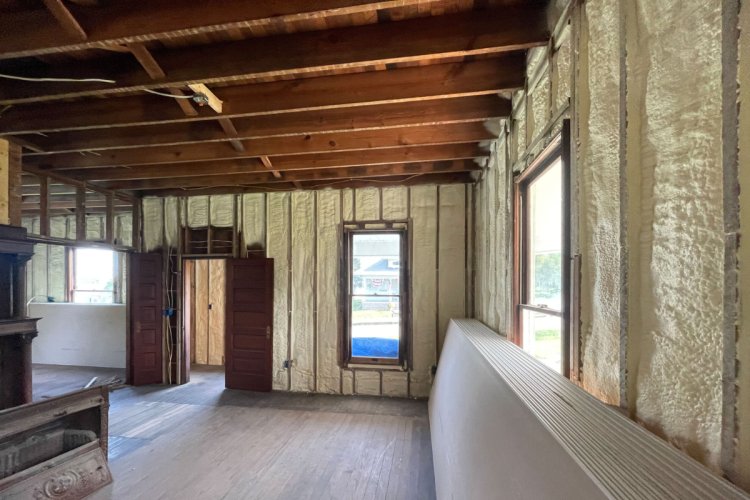Spray Foam vs. Traditional Insulation: What Works Best for St. Louis Homes?
Discover the pros and cons of spray foam and traditional insulation for St. Louis homes. Learn which option offers the best energy efficiency, moisture resistance, and cost-effectiveness for your needs.

We all want our homes to be perfect, which is why we take various measures to protect them from both natural and man-made dangers. One of the best ways to safeguard your home is by insulating it properly. When choosing the right insulation for your St. Louis home, the decision can feel overwhelming due to the many available options. Homeowners often find themselves debating between spray foam insulation and traditional types, such as fiberglass or cellulose. Each type has its own benefits, drawbacks, and specific applications. To make an informed choice, it’s essential to understand the unique properties of these materials and how they perform in the climate of St. Louis.
Understanding Insulation Types
Spray Foam Insulation:
St. Louis Residential Spray Foam Insulation is a versatile and effective material that expands upon application to fill gaps, cracks, and crevices. There are two primary types of spray foam insulation:
-
Open-cell spray foam: This is lightweight, flexible, and provides excellent soundproofing. It’s often used for interior applications.
-
Closed-cell spray foam: This is denser, more rigid, and has a higher R-value (a measure of thermal resistance). It’s ideal for exterior walls, roofs, and areas prone to moisture.
Traditional Insulation:
Traditional insulation refers to more established materials like fiberglass, cellulose, and mineral wool. These materials are often installed in rolls, batts, or loose-fill forms. Key types include:
-
Fiberglass insulation: Made from fine glass fibers, this is one of the most common types of insulation. It’s available in batts, rolls, and loose-fill options.
-
Cellulose insulation: This eco-friendly material is made from recycled paper treated with fire retardants.
-
Mineral wool: Also known as rock wool, this material is non-combustible and provides excellent fire resistance.
Key Considerations for St. Louis Homes
St. Louis experiences a mix of hot, humid summers and frigid, snowy winters, making effective insulation crucial for year-round comfort and energy efficiency. When deciding between spray foam and traditional insulation, consider the following factors:
1. Energy Efficiency
-
Spray Foam: With its superior air-sealing properties, residential spray foam insulation reduces air leakage, helping to maintain consistent indoor temperatures. Closed-cell spray foam has an impressive R-value of around 6-7 per inch, making it one of the most energy-efficient options available.
-
Traditional Insulation: While fiberglass and cellulose also offer good thermal resistance, they don’t seal gaps and cracks as effectively as spray foam. This can lead to air leakage and higher energy bills, especially during St. Louis’s extreme weather months.
2. Moisture Resistance
-
Spray Foam: Closed-cell spray foam acts as a moisture barrier, preventing water infiltration and reducing the risk of mold and mildew. This is particularly beneficial for areas prone to high humidity or water exposure, such as basements and crawl spaces.
-
Traditional Insulation: Materials like fiberglass and cellulose can absorb moisture, potentially leading to mold growth and reduced insulation effectiveness. Proper installation and vapor barriers are essential to mitigate these risks.
3. Durability and Longevity
-
Spray Foam: Once applied, spray foam can last for decades without losing its effectiveness. Its rigid structure resists sagging and settling over time, providing consistent insulation performance.
-
Traditional Insulation: Over time, traditional materials like fiberglass may settle or compress, reducing their insulating capabilities. Cellulose can also degrade if exposed to moisture.
4. Cost
-
Spray Foam: The upfront cost of spray foam insulation is significantly higher than traditional options. However, its energy-saving benefits can offset the initial investment over time.
-
Traditional Insulation: Fiberglass and cellulose are more affordable initially, making them appealing for homeowners on a budget. However, they may require more frequent replacement or maintenance, increasing long-term costs.
5. Installation Process
-
Spray Foam: Professional installation is required due to the specialized equipment and expertise needed. This ensures proper application and maximizes the material’s performance.
-
Traditional Insulation: Many traditional insulation types, such as fiberglass batts, can be installed as a DIY project. However, professional installation is recommended for optimal results.
Advantages and Disadvantages
Spray Foam Insulation Pros:
-
Exceptional energy efficiency and air sealing
-
Moisture-resistant (closed-cell spray foam)
-
Long lifespan and durability
-
Reduces noise transmission (open-cell spray foam)
Spray Foam Insulation Cons:
-
High upfront cost
-
Requires professional installation
-
Potential off-gassing during application
Traditional Insulation Pros:
-
Lower initial cost
-
Easier to install (some types)
-
Variety of options to suit different needs
Traditional Insulation Cons:
-
Less effective at sealing air leaks
-
Prone to moisture absorption
-
Shorter lifespan, with potential settling over time
Choosing the Right Insulation for Your Home
The best insulation choice for your St. Louis home depends on various factors, including your budget, the specific areas you’re insulating, and your long-term goals. Here are some guidelines to help you decide:
-
For Maximum Energy Efficiency: Spray foam insulation is ideal for homeowners looking to minimize energy costs and maximize comfort. Its superior air-sealing properties make it a great choice for both new construction and retrofits.
-
For Moisture-Prone Areas: Closed-cell spray foam is the best option for basements, crawl spaces, and other areas susceptible to water infiltration. It provides a moisture barrier and prevents mold growth.
-
For Budget-Friendly Projects: Traditional insulation materials like fiberglass and cellulose offer good thermal resistance at a lower cost. These are suitable for attics, walls, and other less moisture-prone areas.
-
For Soundproofing: Open-cell spray foam and mineral wool are excellent choices for reducing noise transmission between rooms or from the outside.
Conclusion
St. Louis Residential Spray Foam Insulation plays a critical role in maintaining the comfort, energy efficiency, and structural integrity of your home. Both spray foam and traditional insulation have their merits, but the right choice depends on your specific needs and circumstances.
If you prioritize long-term energy savings, durability, and moisture resistance, spray foam insulation may be the best investment. On the other hand, if you’re working with a tight budget or need a quick solution, traditional insulation options like fiberglass or cellulose can still deliver reliable performance.
For optimal results, consult with professional spray foam insulation experts in St. Louis who understand the unique challenges of the region.
What's Your Reaction?


















